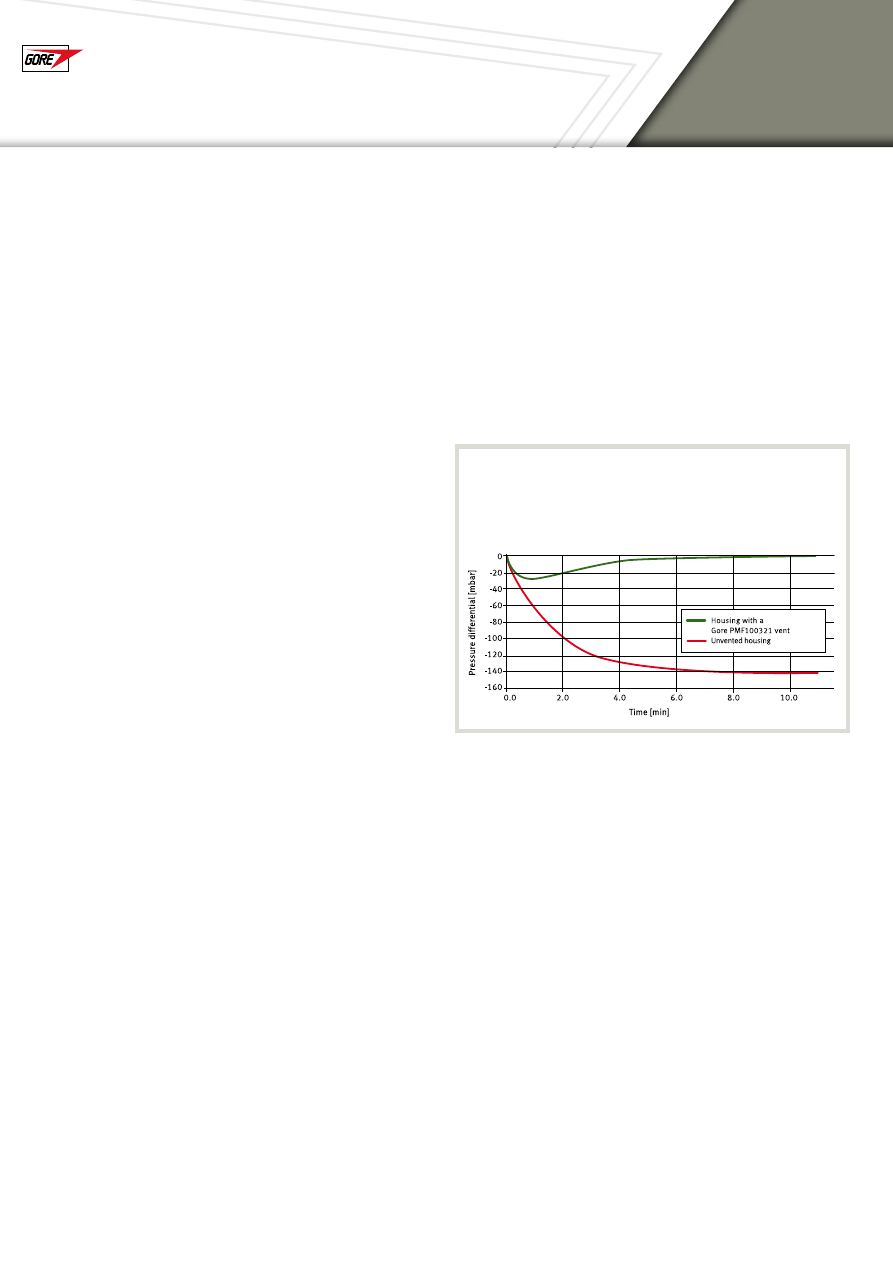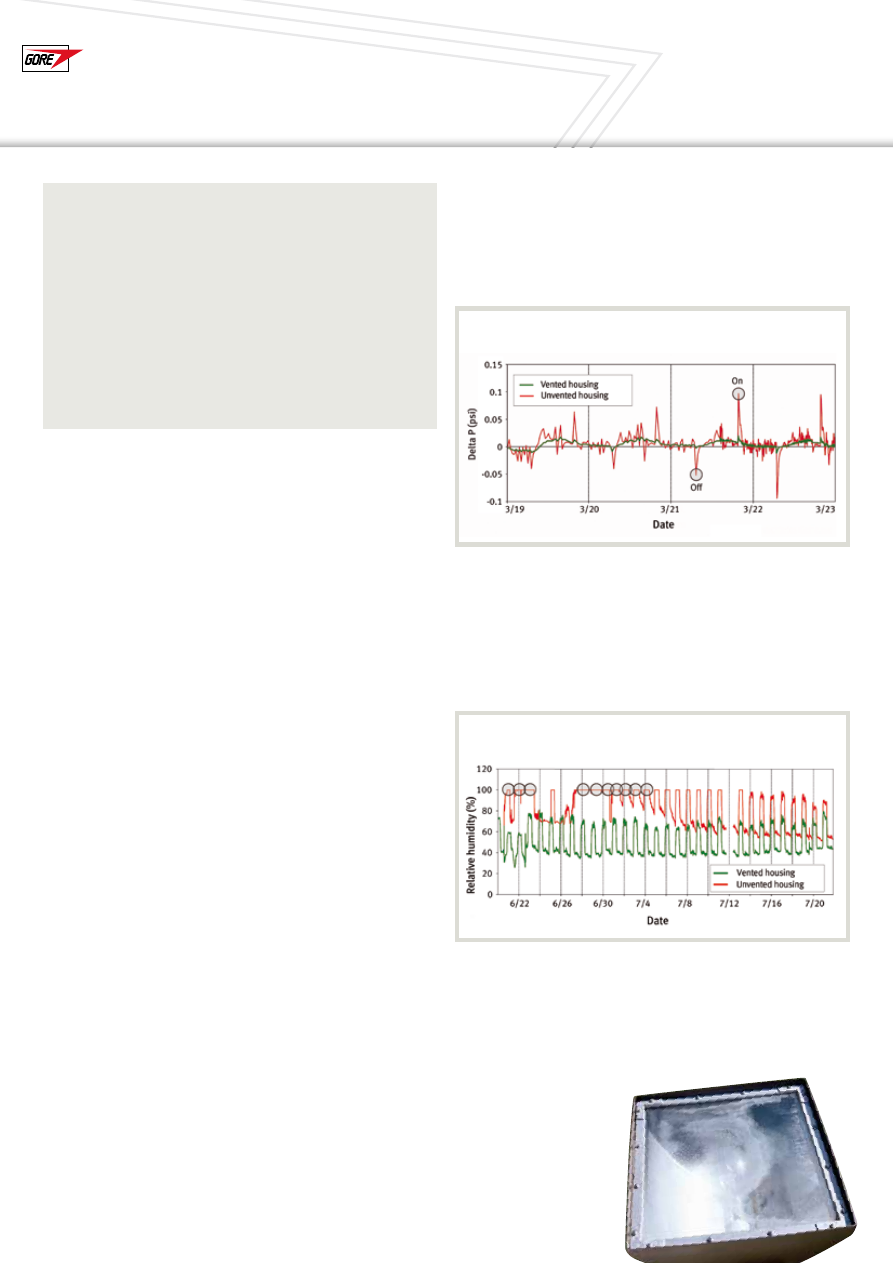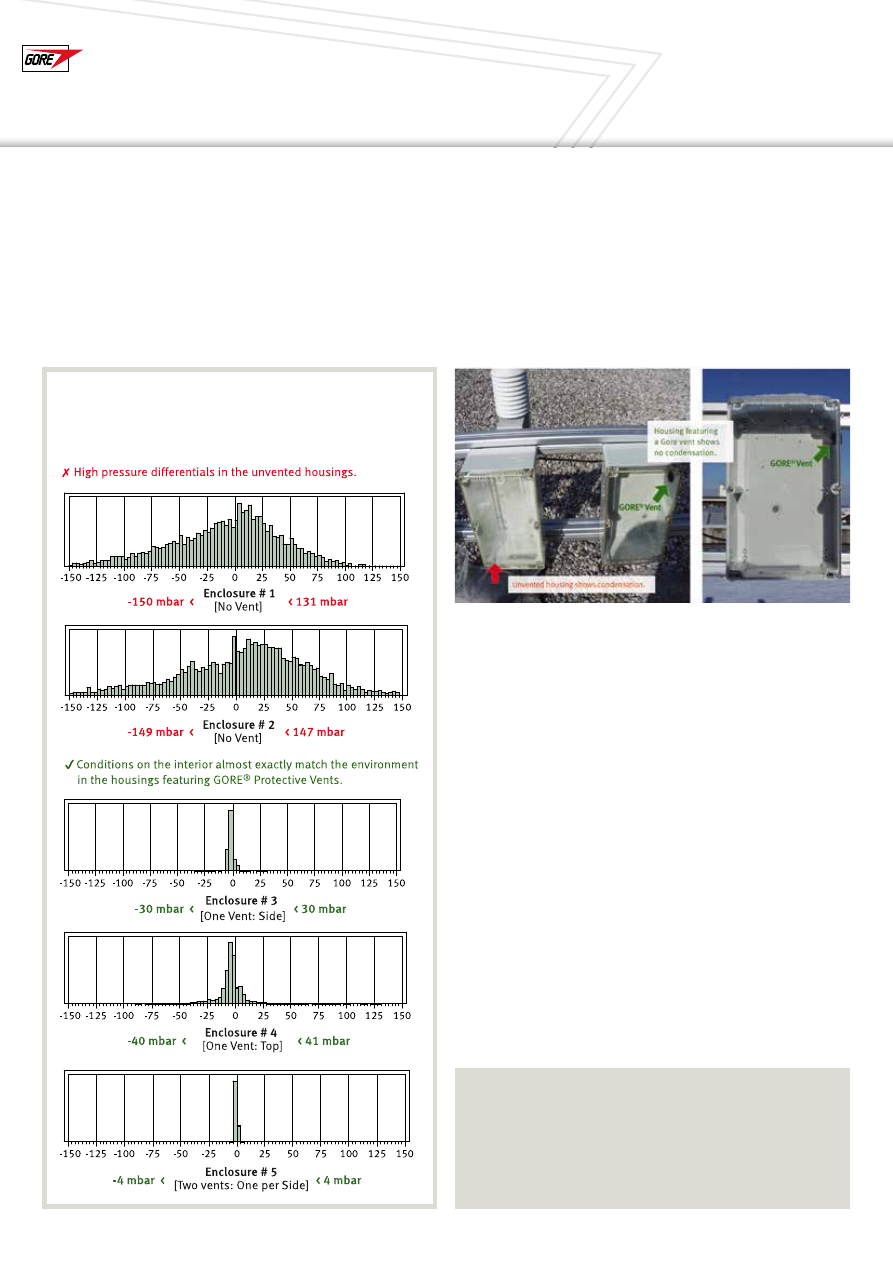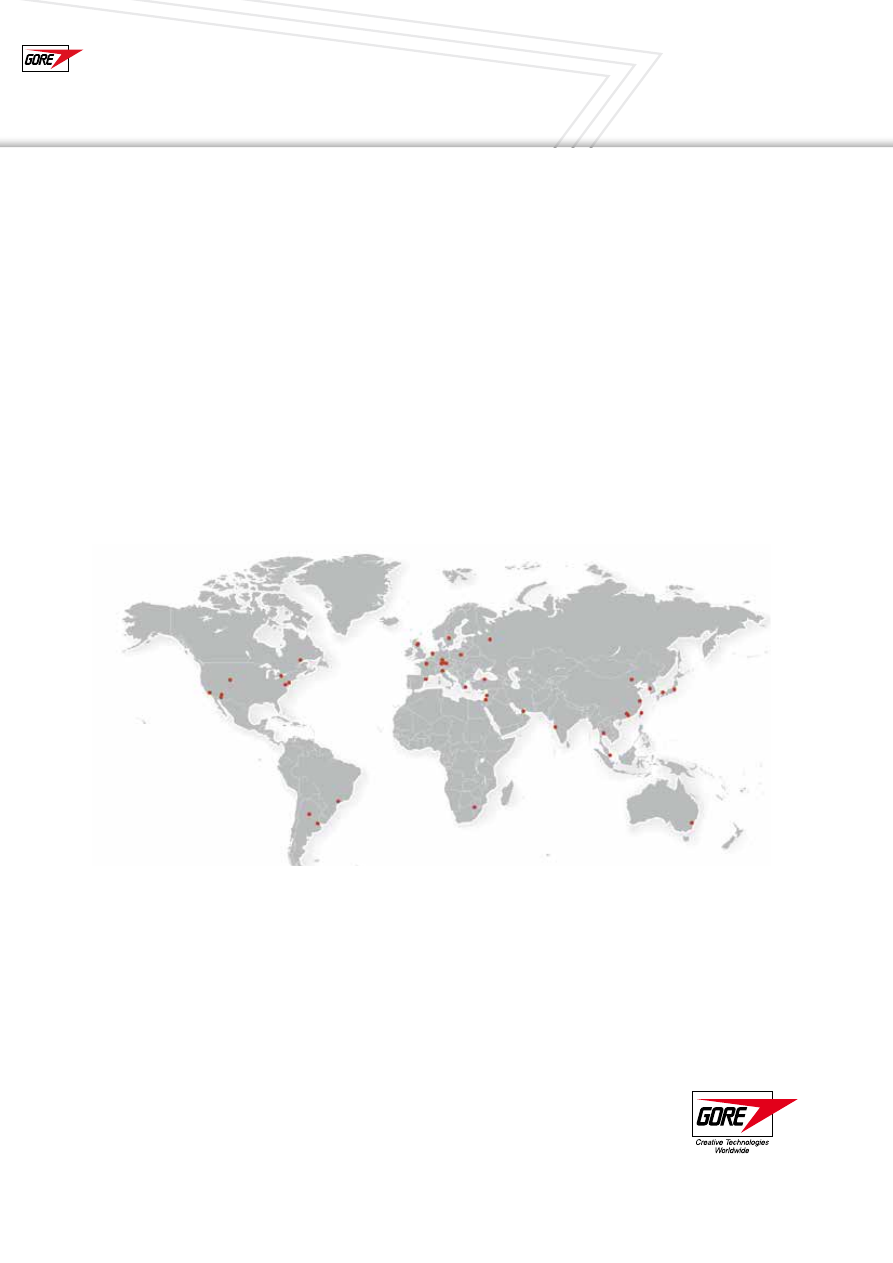
How to Extend the Service Life of LED Outdoor Lighting
By Gary Chan and Henning von Lepel*
can often cause the air inside the LED luminaire to rapidly heat
up, with the resulting higher pressure putting positive pressure
on the seals. As temperatures drop again at night, the internal
air contracts and creates a gentle vacuum, which draws the seals
inward. A quick drop in temperature can create a vacuum of up
to 150 mbar inside the luminaire, while a 30 °C change in
temperature creates approximately 10 percent of volumetric flow
of air in or out in a non-hermetically sealed enclosure.
Figure: Typical calculation of pressure differentials in a housing
Temperature Changes within LED Luminaires
Although LEDs do not get as hot as incandescent lamps,
switching a luminaire on and off nonetheless results in significant
temperature fluctuations. These are at their strongest immediately
after switching, which means that switching luminaires on and
off repeatedly puts not only the electronics but also the seals
under considerable strain.
Altitude Changes
When LED luminaires are shipped by air from their manufacturing
sites, the lamps will be subject to major changes in altitude, even
several times when the shipment involves intermediate stops.
This means LED luminaires are exposed to the difference in
pressure between a little over 1,000 mbar at ground level and
800 to 850 mbar in the aircraft.
Thermal Shock
A thermal shock occurs when a hot LED luminaire is sprayed
with cold water from a garden hose, for instance, or when a cold
luminaire is washed with hot water. It can also arise when a
luminaire encounters snowfall.
LED luminaires in outdoor use need to be protected from harsh
environmental conditions. The most significant stress factor
for the sealings of luminaire housings are pressure differences
caused by everyday temperature changes. In order to protect
the sensitive electronics inside, pressure variations have to be
equalized while preventing water and dust to enter the housing.
The most effective solution is a “smart venting element” with
a membrane that protects electronic housings against con-
tamination and fluids and provides air exchange and pressure
equalization at the same time.
For both commercial and residential applications standard
neon tubes and energy-saving lamps are increasingly replaced
by LED (light-emitting diodes) luminaires. The advantages of
LED lightings are numerous:
• They are fully RoHS-compliant (Restriction of Hazardous
Substances).
• They provide up to 85 percent energy savings in comparison
to conventional lamps.
• They can generate as much as 50,000 hours of light.
• They are one of the most environmentally friendly and reliable
solutions for outdoor lighting applications.
However, the service life of a LED is subject to the reliability
of the electronic components and power supply drivers, which
altogether make up the lighting system itself. This poses a
major challenge on LED systems for outdoor use. The housings
of the LED luminaires must be able to withstand the harsh
environmental conditions. To achieve this goal, the housing
of an LED lamp is sealed against the ingress of water and
contaminants. However, changes in outdoor temperature
cause the air pressure within the housing to fluctuate constantly,
which in turn puts either positive or negative pressure on
the seals and compromises their functionality. Over time,
seals begin to allow water and contaminants to enter the
housing, which can lead to corrosion, shorts, and potential
failure of the electronics. In addition, condensation on the
inside of the luminaire can impact the quality of its light.
Causes for Pressure Differentials
Temperature Fluctuations
Changes in outdoor temperature are one of the most common
causes of pressure differentials. These changes can be sudden,
for instance a strong thunderstorm on a hot summer day, or more
gradual over the course of the day or of the year. Either way, they
put significant stress on the seals. What is more, direct sunlight
White Paper
Typical Calculation
Pressure differential in a housing with 5 liters of free air
volume caused by a temperature drop from 65 °C to 15 °C
in 11 minutes.
Protective Vents
adhesive vents
Gore-PTV-WhitePaper-Service-Life-LED-US-html.html

Challenge: Equalizing Pressure
For maintaining constant pressure inside a luminaire it is crucial
to allow air to flow freely in and out of the luminaire. The challenge
is to block water and contaminants in doing so. Most types of
seals to achieve this goal have multiple drawbacks as explained
below:
• Labyrinth seals are completely permeable to particles,
insects, and water.
• Rugged seals, additional bolts, thicker housings or potting
compounds for hermetically sealing the device require
the use of non-permeable materials and is relatively
expensive. Moreover, it makes the device heavier,
extremely difficult to open under negative pressure and
repair almost impossible.
• Felt elements and sintered vents address the pressure
differentials, but they can become blocked by water
and contaminants.
• A mechanical valve is a one-way solution from inside to
outside, which means it cannot prevent a vacuum.
Solution: “Breathing” Luminaire Housings
Gore has developed a solution: a vent made of expanded polytetra-
fluoroethylene (ePTFE). A two-way breathable membrane continu-
ously equalizes pressure inside the luminaire housing while also
preventing the ingress of water and contaminants. Equalizing
pressure using an ePTFE vent reduces the potential for moisture
vapor to condense on lenses and reflectors, and increases the
service life of seals. The microporous membrane can be coated
to provide oleophobicity. ePTFE’s node-and-fibril microstructure
is open enough to allow gas molecules and vapor to pass through
it easily, but the openings are so small that liquid and other
particulates are repelled. Also, hydrogen sulphide is expelled
this way.
Proper pressure equalization and water tightness have been
demonstrated by thorough testing to compare two commercially
available LED luminaires, one conventionally sealed unit and
one with an ePTFE vent. Although the on/off cycle of both
luminaires caused temperatures to rise and fall, the amount
of pressure placed on the seals is significantly different. In the
sealed luminaire, the pressure spiked by 6.2 mbar when the light
was switched on and dipped -6.9 mbar when switched off. However,
the vented luminaire showed a change of only ±0.69 mbar.
Figure: Impact of pressure on vented and unvented housings.
Comparing the relative humidity inside the LED luminaires after
a standard IPX5 water ingress test demonstrates the significance
of pressure differentials. The relative humidity in the sealed
luminaire was significantly higher than in the vented luminaire.
Over the course of ten days, the relative humidity in the sealed
luminaire almost always remained at around 100 percent.
Figure: The unvented housing shows relative humidity of 100%, indicating
condensation.
This indicated condensation inside the luminaire caused by water
entering during the test. Although the relative humidity in the vented
luminaire rose immediately after the shock test, it decreased again
relatively quickly and there was no evidence of condensation.
Figure:
Luminaire with condensation
Important Consideration: Hydrogen Sulfide
Not only constant pressure is important for a long service
life of an LED luminaire. Hydrogen sulfide is given off
especially by inexpensive EPDM seals produced using
sulfur vulcanization where not all the sulfur atoms were
one-hundred per cent cross-linked. Sulfur vulcanized nitrile
butadiene rubber (NBR) or other components containing
sulfur can also give off hydrogen sulfide. This substance
corrosion in luminaire components such as silver-plated
leadframes, which could impact electrical contacts with
the wire bond or die bond.
Impact of pressure on vented and unvented housings.
Relative humidity in vented and unvented housings.
White Paper
Protective Vents
adhesive vents
Gore-PTV-WhitePaper-Service-Life-LED-US-html.html

Comparison Test Proves
Long-Term Protection
A further test, conducted outdoors over a period of five years south
of Munich, demonstrated the longer service life of vented enclosures.
Five units were tested: two with no vents, one with a side vent, one
with a top vent, and one with two vents (one on each side). The
testing showed that the pressure differential in the unvented units
ranged from -150 mbar in both to 131 and 147 mbar respectively.
Figure: Long-term study of pressure differentials in electronics housings
A significant amount of condensation was also detected.
In the vented units, the maximum pressure measurements fell
to ±40 mbar with a top vent, ±30 mbar with a side vent, and
just ±4 mbar with both vents. This is an impressive demonstration
of how effective these venting systems are at equalizing pres-
sure. In addition, no condensation was detected, and neither
was the ingress of water or dust. Further testing showed that
the vents were fully functional even after five years of outdoor
operation.
Figure: Long-term study of pressure differentials in electronics housings
Roundup: Venting Solutions Extend the
Service Life of Outdoor LED Luminaires
Pressure differentials compromise housing seals. Not taking
this into account when designing LED luminaires can reduce
the service life of LEDs, power supply drivers and other
electronics. The ingress of water through damaged seals also
leads to condensation on lenses and reflectors that can
decrease light efficiency and the aesthetic quality of the
luminaire. As demonstrated through the IPX5 test, integrating
an ePTFE vent into the housing equalizes pressure by allowing
continuous airflow in both directions and preventing the ingress
of water. What’s more, the vent reduces condensation because
moisture vapor is able to escape from the luminaire before
condensing.
* Gary Chan and Henning von Lepel are Application Engineers
at W. L. Gore & Associates
Long-term study of pressure differentials
in electronics housings
Over a period of five years, pressure differentials were recorded
in five housings.
Long-term study
You will find more information on this topic in the long-term
study “Life Time Study of GORE
®
Protective Vents installed
in Enclosures in Outdoor Environments”, which you can
download from
www.gore.com/5-year-study
.
White Paper
Protective Vents
adhesive vents
Gore-PTV-WhitePaper-Service-Life-LED-US-html.html

PT
V-115-
WHP-EN-A
UG14
FOR INDUSTRIAL USE ONLY. Not for use in food, drug, cosmetic or
medical device manufacturing, processing, or packaging operations.
All technical information and recommendations given here are based on Gore’s previous experiences and/or test
results. Gore gives this information to the best of its knowledge, but assumes no legal responsibility. Customers
should check the suitability and usability in the specific application, since the performance of the product can
only be judged when all necessary operating data are available. The above information is subject to change and
is not to be used for specification purposes.
Gore’s terms and conditions of sale apply to the sale of the products by Gore.
GORE, GORE-TEX and designs are trademarks of W. L. Gore & Associates.
© 2014 W. L. Gore & Associates GmbH
Please Contact Gore to
Learn About the Right
GORE
®
Protective Vent for
your Unique Application
International Contacts
W. L. Gore & Associates GmbH
Wernher-von-Braun-Str. 18 • 85640 Putzbrunn • Germany
Tel.: +49 89 4612 2211 • Fax: +49 89 4612 2302
E-mail: protectivevents@wlgore.com
gore.com/protectivevents
About W. L. Gore & Associates
Gore is a technology-driven company focused on discovery and product
innovation. Well known for waterproof, breathable GORE-TEX
®
fabric,
the company’s portfolio includes everything from high-performance
fabrics and implantable medical devices to industrial manufacturing
components and aerospace electronics. Gore products have remained
at the forefront of creative solutions because they are engineered
specifically for challenging applications requiring durable performance
where other products fail.
For almost thirty years, Gore has delivered venting solutions for a
variety of applications working in rugged environments throughout the
world — applications for heavy-duty equipment and the automotive
industry; electronic housings for the solar, lighting, security and
telecommunication market; mobile electronic devices; and chemical
and agricultural packaging. Engineered with the latest materials and
technology, Gore’s vents are backed by years of research and testing
to help extend product life and enhance reliable performance — all
to ensure that these venting products can meet the challenging
environments and application demands of today’s technology.
Headquartered in the United States, Gore employs approximately
10,000 associates in 30 countries worldwide. In Europe, Gore started
its first business operations only a few years after the Enterprise’s
founding in 1958.
Learn more at gore.com/protectivevents
.
Australia
+61 2 9473 6800
Benelux
+49 89 4612 2211
Brazil
+55 11 5502 7800
China
+86 21 5172 8299
France
+33 1 5695 6565
Germany
+49 89 4612 2211
India
+91 22 6768 7000
Italy
+39 045 6209 240
Japan
+81 3 6746 2572
Korea
+82 2 393 3411
Mexico
+52 81 8288 1281
Scandinavia
+46 31 706 7800
Singapore
+65 6733 2882
South Africa
+27 11 080 6150
South America +55 11 5502 7800
Spain
+34 93 480 6900
Taiwan
+886 2 2173 7799
Turkey
+90 216 3935749
United Kingdom +44 1506 460123
USA
+1 410 392 4440
White Paper
Protective Vents
adhesive vents



